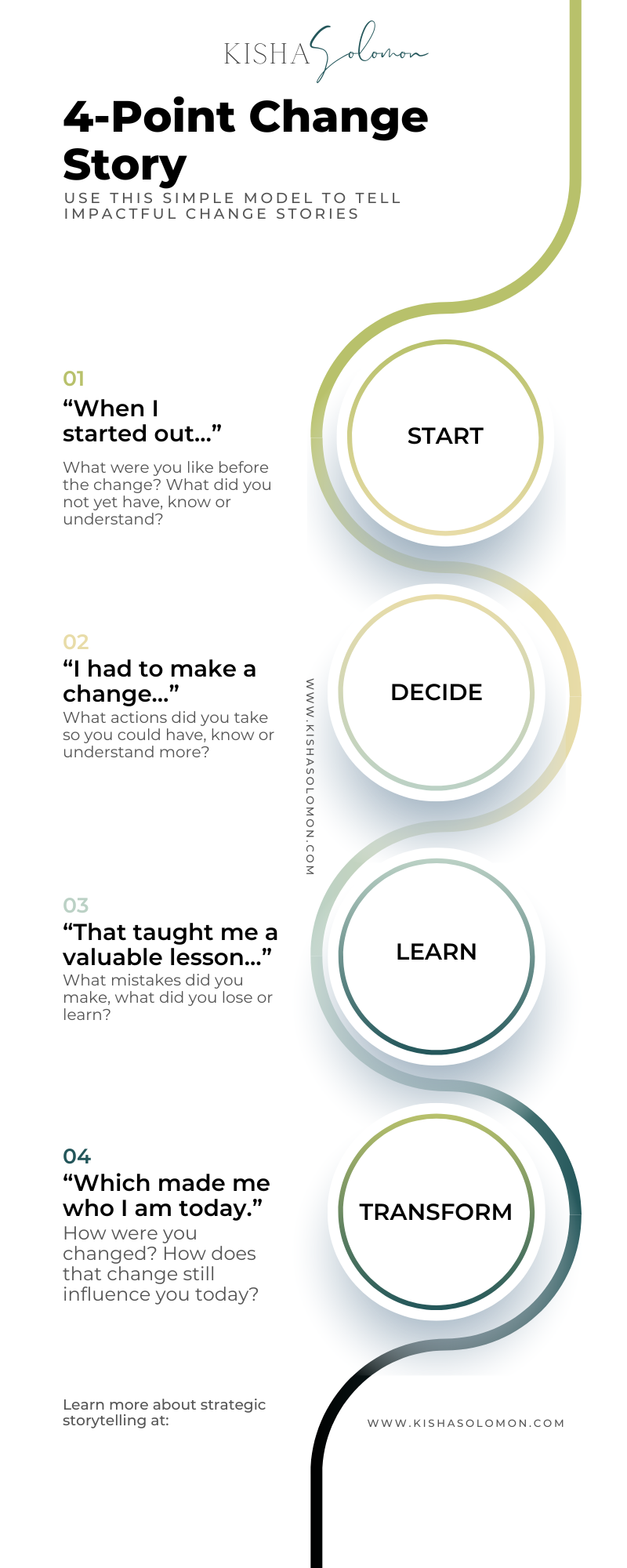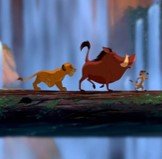How to Tell Impact Stories: A Simple Formula
Need to tell an impact story for your project or program? Here’s a simple 4-part formula along with examples of when to use it.
if you want to tell a compelling impact story, Tell a story of change or transformation.
Stories of change and transformation take your audience on the journey from before to after. These stories grip your audience’s attention, inspire them and can even compel them to take action.
Any change or transformation story can be broken down into the following 4 parts:
Part 1 - Start
Part 2 - Decide
Part 3 - Learn
Part 4 - Transform
Using these 4 parts, you can quickly and consistently structure a story of change about yourself, your team, your customer or your organization.
One universal example I like to use to illustrate the use of this method - a method that I refer as the 4-Point Story Model - is the movie, The Lion King. In the move, the main character, Simba, goes through a transformation that can be mapped using the 4-Point Story Model.
Part 1 - The START
At the start – the main character exists in an unchanged state (zone of comfort or lack of awareness).
In the Lion King, this is when Simba is a cub protected by his father Mufasa.
02 DECIDE
Then something happens – It forces the main character to make a decision / to move away from the comfort zone / toward greater awareness.
In the Lion King – this is when Mufasa is killed by Scar and Simba runs away to live a carefree life
03 LEARN
But before they can get there – there’s a price to pay or a lesson to learn. Usually as a result of failure or setback.
Back home, Simba’s family suffers drought & starvation at the hands of the cruel leader Scar. The wise Rafiki reminds Simba of his responsibilities.
04 TRANSFORM
Finally the main character returns – a different & more expanded, mature or aware version of who they were at the start.
With his new friends by his side, Simba returns, defeats Scar. He becomes the new king and a father to his own lion cub.
When to use the 4-Point story MOdel
The 4-Point Story Model has been useful in a number of situations where I’ve needed to relay a story of how someone or something went through a process that resulted in significant or measurable change, aka, impact stories.
I often use the story model to help me bring more interest to storytelling scenarios where there’s a lot of context to be conveyed, and data alone won’t do. Below are a few examples of when I’ve used the model:
Team retrospectives, lessons learned
Leadership bio / team summary
Project start / update / closeout
Team member intro / exit
Performance assessments, 1:1 sessions
Product or service launch / new feature release
Strategic decision-making
Customer interviews
Download My Free Storytelling Ebook
Don’t know what story to tell or how to tell it? Learn a simple method for telling compelling impact stories. Create a draft of your own signature story. Download Now.
The 4-Point Story Model for Telling Compelling Stories
Any change or transformation story can be broken down into the following 4 parts.
What makes a story compelling? What is it about some stories that make us want to sit up and take notice or even take action?
Often, it’s stories of change or transformation that we find most inspirational or compelling. When we see a main character experience and learn from something it reminds us of our own growth experiences and can even give us a role model for navigating moments of change in our personal stories.
So, if you want to tell a compelling story. Tell a change story.
Story circles are visual structures for change & transformation stories.
www.kishasolomon.com
Story circles are perfectly suited to help structure a change or transformation story. The 2 most popular story circles are Dan Harmon’s story circle and The Hero’s Journey. Each shows how a main character goes through a series of steps to undergo a personal transformation. These story structures are the foundation for many popular books, tv shows and films throughout history.
They are, however, a bit cumbersome and difficult to remember. For that reason, I like to rely on a slimmed-down version of the story circles to help me structure compelling stories. For me, it’s the simplest way to tell a story.
The 4-Point Story Model - The Simplest Way to Tell a Story
Download my free ebook to learn how to use the 4-point story model to tell your signature story.
Download My Free Storytelling Ebook
Don’t know what story to tell or how to tell it? Learn a simple method for telling compelling impact stories. Create a draft of your own signature story. Download Now.
Any change or transformation story can be broken down into the following 4 parts:
Start
Decide
Learn
Transform
Using these 4 parts, you can quickly and consistently structure a story of change about yourself, your team, your customer or your organization.
One universal example I like to use to illustrate the use of the 4-Point Story Model is the movie The Lion King.
In it, the main character goes through a transformation that can be mapped using the 4-Point Story Model.
01 START
At the start – the main character exists in an unchanged state (zone of comfort or lack of awareness).
In the Lion King, this is when Simba is a cub protected by his father Mufasa.
02 DECIDE
Then something happens – It forces the main character to make a decision / to move away from the comfort zone / toward greater awareness.
In the Lion King – this is when Mufasa is killed by Scar and Simba runs away to live a carefree life
03 LEARN
But before they can get there – there’s a price to pay or a lesson to learn. Usually as a result of failure or setback.
Back home, Simba’s family suffers drought & starvation at the hands of the cruel leader Scar. The wise Rafiki reminds Simba of his responsibilities.
04 TRANSFORM
Finally the main character returns – a different & more expanded, mature or aware version of who they were at the start.
With his new friends by his side, Simba returns, defeats Scar. He becomes the new king and a father to his own lion cub.
When to use the 4-Point story MOdel
The 4-Point Story Model has been useful in a number of situations where I needed to relay a story of how someone or something went through a process that resulted in significant or measurable change.
I often use the story model to help me bring more interest to storytelling scenarios where there’s a lot of context to be conveyed, and data alone won’t do. Below are a few examples of when I’ve used the model:
Team retrospectives, lessons learned
Leadership bio / team summary
Project start / update / closeout
Team member intro / exit
Performance assessments, 1:1 sessions
Product (svc) launch / feature release
Strategic decision-making
Customer interviews
Common Growing Pains for Teams
When your team is called upon to do or be something different, how do they respond?
There will come a point in your team’s journey where you recognize that what got you to the current level of success will not get you to the next level of success or growth that you desire.
In order to ‘level up’, you’ll need to take a long, hard look at the habits, behaviors and mindsets that your team has developed, and determine which ones are blocking you from achieving the next level of growth.
The longer you delay or put off that process, the more growing pains you are likely to feel.
Here are some of the most common growing pains I’ve seen my own teams and my clients’ teams experience on their journeys to growth and change.
Common Team Growing Pains
Lacking a clear vision of where the team is headed or what success looks like
Too focused on ‘the way we’ve always done it’
Difficulty shifting from leader-driven to team-driven
Team members’ responsibilities are undefined
Difficulty showing or measuring what the team accomplished, how much progress they’ve made or how close they came to the goal
Unable to turn long-term strategy into an actionable plan
Team members are more order-takers than decision makers
How many of these growing pains is your team experiencing?
IF YOU WANT TO CHANGE YOUR FUTURE
CHANGE YOUR STORY.
Create A Strategic Story To Map Your Future In Times of Growth & Change
5 things you should know before taking a big leap in life
If you’re preparing to take a big leap in your life or career, here are a few mindful tips to help you get your head right for the adventure ahead.
If you’re preparing to take a big leap in your life or career, here are a few mindful tips to help you get your head right for the adventure ahead.
The trick for dealing with change?
Embracing what it can teach you. This, of course, is easier than it sounds. Fear and doubt always seem to show up whenever you’re thinking of making a major life change. An endless loop of worries and worst-case scenarios play in your mind. This ‘monkey mind’ loop can keep you chasing your own thoughts down a spiral of anxiety, and ultimately, inaction. more>
Telling your own story is an essential life skill.
When you define yourself for yourself and become the writer of your own story, life’s major changes, setbacks or shifts become one-of-a-kind opportunities for you to evolve from victim to hero. more>
Taking a big leap involves risk.
A risk of failure, of looking silly, of hurting yourself. Big leaps involve stepping out into the unknown. Going off the one-size-fits-all plan. They require you to trust yourself more than you ever have. They are an exercise in faith. more>
Personal mastery is the reward for overcoming fear…
…shifting your mindset from ‘one-size-fits-all’ and taking worthwhile risks.
It all starts with the small, everyday habits and behaviors you practice BEFORE you take a big leap, make a major life change or face an unexpected life challenge. Until you ‘get your mind right’, your potential for growth and self-mastery will be limited. more>
Your work and relationships are a reflection of what you think of yourself.
As you evolve, the way you relate to your job and to the people in your life - family, friends, significant other - will evolve too. At some point, you may feel the need to graduate. This can be a literal leaving behind or a ‘leveling up’ of the way you engage and the effort and energy you give to these experiences.
IF YOU WANT TO CHANGE YOUR FUTURE
CHANGE YOUR STORY.
Write your next chapter with a story-based strategic framework that evolves as you do.
3 Organizational Responses to Change
When it comes to change and uncertainty, there's usually three responses. And two of those responses are growth limiting responses. While one response is a response that allows for growth in the face of uncertainty and change.
Video Transcript:
When it comes to change and uncertainty, there's usually three responses. And two of those responses are growth limiting responses. While one response is a response that allows for growth in the face of uncertainty and change.
So the first response is the ostrich response. And if you know about ostriches, that basically means when change or uncertainty occurs, you put your head in a hole, you ignore it. You shut it out, you block it, you don't pay any attention to it, and you just pretend like it's not happening. So it's like, put your fingers in your ears and go, la la la, la, la. No change, no change, no change. And that's the ostrich response.
The roadrunner response is to run. So when you see change or uncertainty happening or some sort of difficult change or uncertain state of affairs occurring, you run from it. You move from that place to a place of greater comfort that probably looks more like the old place did before it started changing. So you just run from the change and go back to someplace that represents an unchanged state of being.
And then the final way is Wiley. And Wiley Coyote, if you know from the cartoons, is someone who is constantly innovating, trying new methods, new tools, new techniques, new approaches. But never stops. Like every day, gets up and tries again, tries a new product, tries a new technique, tries a new method. And it seems like there's never going to be a point where Wiley can succeed or will actually be able to grasp what he's going after.
What we see in the cartoon is Wiley is constantly chasing this Roadrunner. But he's always getting outsmarted or evaded in some way. But then we also recognize part of why Wiley keeps getting up and chasing the Roadrunner is not because he wants to catch him, it is because he enjoys the process of the chase. He actually enjoys trying out new tools. He enjoys innovating, he enjoys coming up with different methods. He likes the paces that it puts him through because it keeps him entertained and, and probably quite fit.
So I think those three approaches to change really represent the natural responses that people or teams, or organizations have when change is presented. One is to just ignore it, and those who ignore it run the risk of basically getting bulldozed by that change. If you stand in one place while change is hurtling towards you and you just dig your head in the sand or dig your heels in, then what's gonna happen is you're gonna be knocked over by that change. You're gonna be in some way devastated by it because you're never prepared for it.
The people who run from change in the short term, they find that it feels good. They find themselves back in a place of comfort. But the challenge with running backwards is that you never get ahead. If you're constantly running to something that is pre change or represents an unchanged state, then basically you're starting from scratch or you're always behind the curve. You're always behind the state of progress that is happening in the environment. So that looks like you either standing still or regressing.
And then the final one is really evident of, well, when you're responsive to change by being innovative and iterating your approaches and trying different things, what may happen is you find that once you've actually adopted the change, you're like, okay, well what do I do next?
Now I actually have to think of something else to do because after all of this trying and learning and experimenting, I actually got through the change. And throughout that process, I've actually learned and grown a lot. I've learned a thousand ways that didn't work just to get to the one way that did work. And so the next time I'm going through change, I can actually probably get to that change a lot faster than I did before.
So these are three approaches, and I think the first two are approaches that very clearly limit growth. And the Wiley approach is actually the one that is going to help you succeed even before you're actually fully able to master the change.
How does your team or organization respond to change?
IF YOU WANT TO CHANGE YOUR FUTURE
CHANGE YOUR STORY.
Create A Strategic Story To Map Your Future In Times of Growth & Change






















